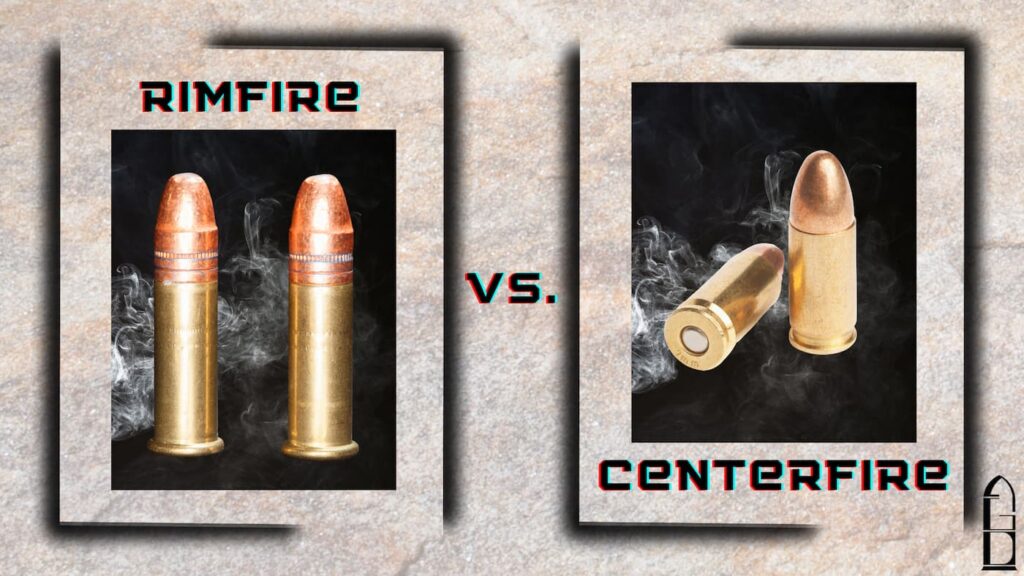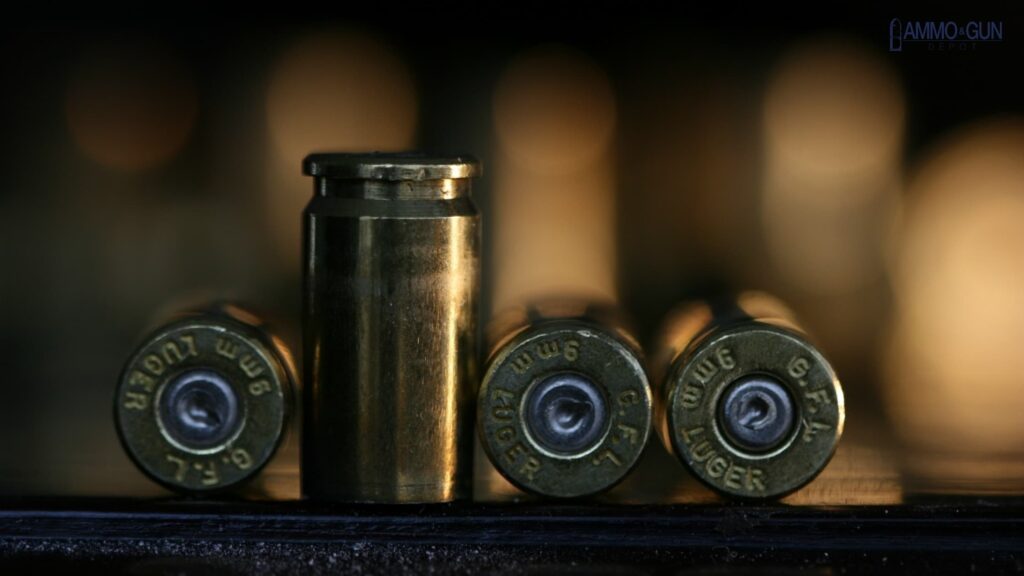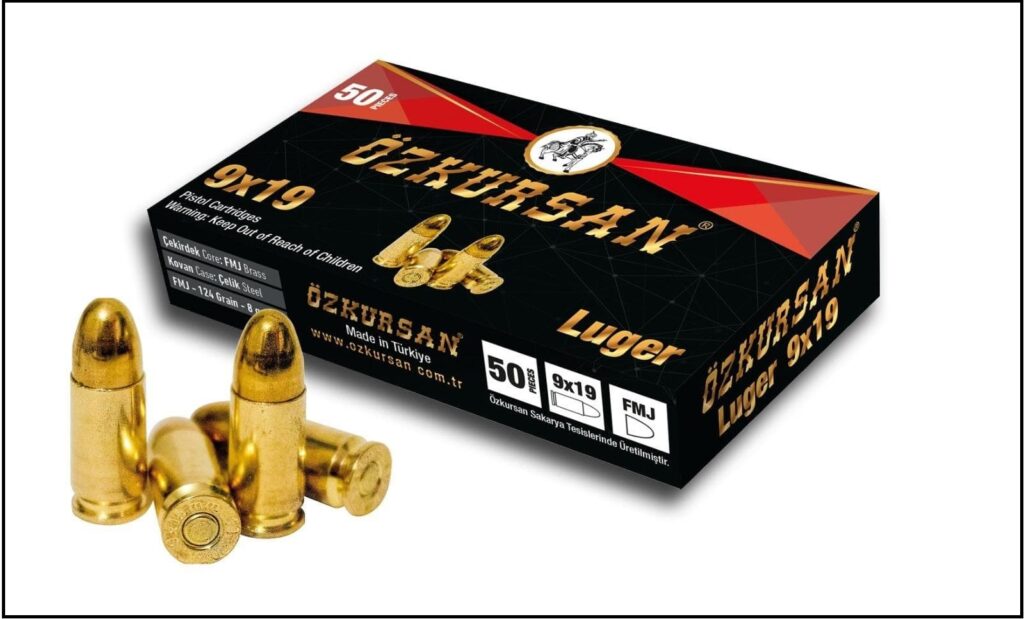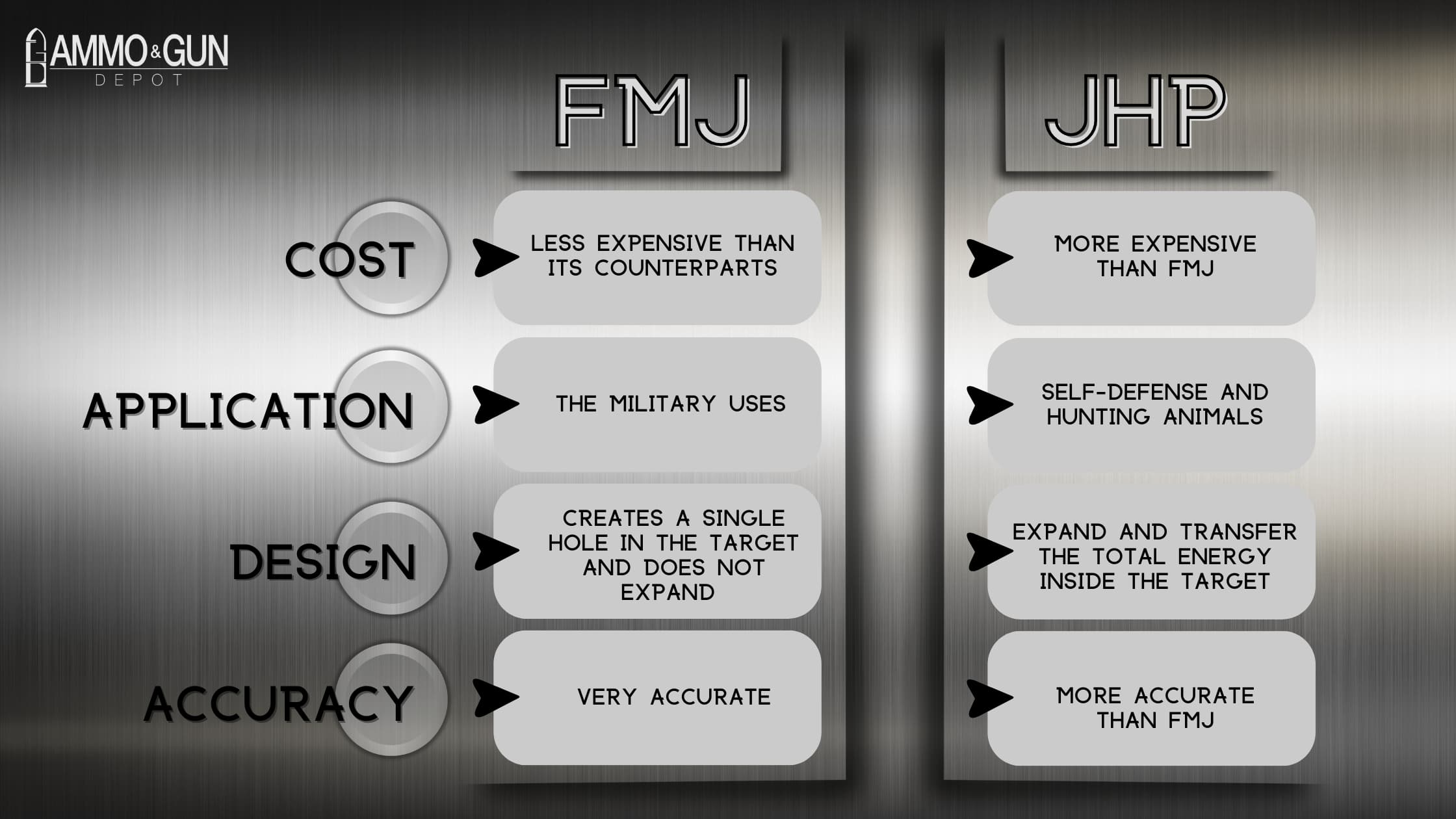- Free Shipping - Same day Fast shipment if order is placed by 2.00 pm EST - Only Delivery no ın-store shoppıng
- Last Update :
- October 4, 2022
Looking to go hunting or practice shooting, and you are not sure what type of firearm to get? Say no more because this article gets you covered. In this article, you will understand the perfect ammo for hunting, self-defense, or shooting lessons.
As we move on, you will understand everything to know about rimfire and centerfire ammunitions, their pros and cons, and the comparison between both types of ammunition – Rim fire vs. Center fire.

Parts Of A Cartridges
What most people call bullets are known as Cartridges. A bullet is part of a cartridge. There are two types of ammunition according to how their primer is ignited; they are Rimfire ammunition and Centerfire ammunition.
Cartridges are made up of 4 parts – a case, the primer, propellant, and the bullet or projectile.
Case
The case is the metallic container that houses all the different components of the cartridge.
The Primer
When struck by the firing pin, the primer is the part of the cartridge that ignites the gunpowder. Also, it is an explosive chemical compound, and the location of the primer is one difference between centerfire and rimfire ammunition. For rimfire ammunition, the primer is located at the rim of the case, while for centerfire ammunition, it is at the center of the base of the case.
Propellant Or Gunpowder
Gunpowder is a chemical compound that reacts quickly after it is ignited by the primer to cause a gas that expands rapidly and propels the bullet to hit the target.
The Bullet Or Projectile
The bullet is otherwise known as the projectile, which is the part of the cartridge that goes out of the case to hit the target.
What Are The Common Types Of Ammunitions / Bullets
Firearm owners should understand bullets well, depending on the firearm and purpose. Bullets are of different types, and the following are some of the popular bullets;

Full Metal Jacket
The full metal jacket is the most common type of bullet, and they are preferred for accuracy. The full metal jacket bullet is made up of both a hard shell and a soft inner. The hard outer shell protects the soft inner from melting too quickly, improving the bullet’s trajectory.
Hollow Point
Hollow points are preferred when penetration of the bullet is needed. They are typically used by security personnel for self-defense, etc., and they also have high accuracy.
Open Tip
Open-Tip bullets have a small indentation at the tip, hence the name Open-Tip. They are also called Open-Tip Match and are used when shooting long-range distances.
Ballistic Tip
These bullets are also known as Base-Tail bullets. They are used when precision is needed because the tapered tip helps the bullet’s trajectory. Ballistic Tip bullets are the combination of both FMJ bullets and hollow bullets.
Soft point
Soft point bullets are used when expanding bullets are needed for big games like deer and bears. Also, part of the lead is exposed at the tip. Many hunters use soft point bullets, and they are available for handguns and rifles.
Shotgun
A shotgun bullet is a very lethal bullet and is used for self-defense. It comes in different sizes, the most popular size being the 12 gauge. A shotgun bullet is a close-range weapon, and the closer the proximity to the target, the more lethal it is.
History of Rimfire And Centerfire
The centerfire vs. rimfire ammunition argument is a discussion that has been going on for years. In 1831, a patent evolved from the idea of placing a priming compound on the rim of the cartridge, and a thin-walled case will cover the priming compound. The argument is an important one, and firearms owners need to know the history of these two types of ammunition.
History Of Rimfire
In 1845, the first metallic rimfire cartridge invented a Frenchman Louis-Nicholas Flobert. The cartridge is called .22BB Cap (Breeched Bulleted Cap), and the percussion cap is used as the propellant. In 1888, the .28 CB Cap was introduced, and it was slightly more powerful than the .22BB Cap.
Both cartridges are called the Flobert 6mm cartridge, but they both have a relatively low muzzle velocity of 213m/s to 244 m/s because it does not use gunpowder as a propellant. Flobert also developed rifles and pistols for these cartridges, and these firearms were used for indoor shooting and were referred to as ‘Parlor guns.’
In 1857, the .22 Short rimfire cartridge was the following rimfire ammunition, and it was developed for Smith and Wesson’s first revolver. It had a longer case than the Flobert 6mm cartridge and 260 mg (4 grains) of gunpowder used to fire a conical bullet. In 1857, the .22 Long was developed. It had the same bullet weight as the .22 Short but with a longer case and more gunpowder (320mg). In 1880, the .22 Extra long was developed, and it had a longer case than the previous .22 cartridges, and it had a heavier bullet.
In 1886, J Stevens Arms and Tool Company developed the .22 Long Rifle, which had a higher muzzle velocity than the Flobert 6mm cartridges. The .22 Long Rifle uses a heeled bullet and is one of the few cartridges still in use by a large variety of rifles and handguns. The development of .22 LR rendered previous cartridges like .22 Long and .22 Extra Long obsolete.
During the American Civil war, large rimfire calibers like .17 caliber, .30 rimfire, .32 rimfire, .38 rimfire, .41 short, .44 Henry, and .56 Spencer, etc., were used. Centerfire versions quickly replaced these large calibers, but the .22 caliber rimfire is the large caliber from the early days still in use. The 21st century saw the development of the 17 HMR (Hornady Magnum Rimfire), .22WMR, and .17HM2 cartridges with high muzzle velocity.
History of Centerfire
Jean-Samuel Paul invented the early form of centerfire ammunition between 1808 and 1812. The first invention was without a percussion cap, and it was used as a form of obturation and was also the first fully integrated cartridge. In 1829, Frenchman Clement Pottet invented another form of centerfire ammunition but perfected the design in 1855. Some notable names like Béatus Beringer, Benjamin Houllier, Gastinne Renette, Smith & Wesson, and Jules-Félix, to mention but a few, all improved the centerfire cartridge and centerfire guns.
Rimfire Ammunition
Rimfire ammunition is a type of firearm cartridge with the primer located at the rim of the case, and the firing pin strikes the rim to cause an ignition that fires the bullet to the target.

source: https://www.concealedcarry-ed.com
How Far Can A Rimfire Bullet Travel?
Rimfire ammunition is mainly used for hunting small pests, inexperienced training, and sports shooting. The .22 Long Rifle is a type of Rimfire ammunition and one of the most common in the world in terms of units sold. For short ranges, the .22 LR is effective for up to 150m (140yards) and can travel as far as 2000yards (1800m).
Rimfire Ammo Examples
In this section, we will talk about 2 popular rimfire ammo examples; .22 LR and .17HMR.
.22 LR
This is the most common ammo in the world because it is easy to buy and cheap. It has virtually no recoil and is mostly used to practice shooting or varmint hunting. The .22LR was introduced to the market in 1884, and it has grown to become the go-to ammo for new firearms owners.
.17 HMR
The .17 HMR (Honarchy Magnum Rifle) ammo is a newer entry, and it was developed in 2002. The .17HMR has a much flatter trajectory and frangible hollow point bullets, which puts it at an advantage over other rimfire cartridges.
Common Types Of Rimfire Ammunitions
Rimfire ammunition is a thin-walled case cartridge. Hence, it is limited to small calibers. Common types include;
- .22 Short: It is not popular ammo but is used in some revolvers
- .22 Long Rifle (LR): It is the most common worldwide.
- .22 WMR: Winchester Magnum Rimfire.
- .17 HM2: Hornady Mach 2: It has higher power than the .22 LR but is smaller. The smaller version of the HMR.
- .17 HMR: Hornady Magnum Rimfire.
- .22 BB Cap and .22 CB Cap: They are also known as 6mm Flobert Cartridge.
- 9mm Flobert:
9x19mm Parabellum
9x19mm Parabellum is a popular cartridge that is worthy of note. In 1901, Austrian firearm designer Georg Luger designed the 9x19mm Parabellum. It is a rimless, tapered firearm cartridge known as 9mm Parabellum or 9mm Luger, and it is one of the most widely used cartridges for handguns and submachine guns because of its cost.
Centerfire Ammunition
Centerfire ammunition is a type of firearm cartridge with its primer located at the center of the case, and the firing pin strikes the center primer to cause an ignition that fires the bullet to the target.

How Far Can A Centerfire Bullet Travel
One advantage of a centerfire bullet over a rimfire bullet is that it can travel farther than the rimfire bullet. A centerfire bullet can travel for several miles, unlike the .22 LR, which can travel for about 1.5miles.
Centerfire Ammo Examples
The military and police use modern centerfire ammo. The most popular centerfire ammo is 9mm and 5.56mm. The 9mm caliber is used in handguns, while 5.56mm is used in rifles. Another popular handgun on the market is the Glock handgun.
Primers
The Primer is a significant feature of centerfire ammunition. The primer is a metal cup located at the center of the cartridge and contains an explosive. For centerfire ammunition, there are primarily two types of primers. Berdan primer and Boxer primer. Berdan and Boxer primers are two primers that are difficult to distinguish just by looking at the cartridge.
Berdan Primer
Col. Hiram Berdan invented the first variation of the Berdan primer. The American inventor then went on to patent his invention in 1866. The Berdan primer was built to use copper shells but there was a problem with reliability when testing started. The anvil is a small vent-hole fashioned from the case, located beneath the primer cap.
For the copper shells, when the firing pin presses the primer cap from outside, it causes swelling of the copper shells, which prevents reliable seating of cartridge in the firearm. Berdan decided to improve the design by using brass shells instead. The use of brass shells solves the reliability problem and also the issue of installing a primer cap into the cartridge. This design is still in use to this day.
Boxer Primer
Boxer Primer was invented by an Englishman, Col. Edward Boxer. Col Boxer patented his design first in England on October 13, 1866, and then received a US patent on June 29, 1869, for his design. Boxer primer and Berdan primer are similar but with a major difference, which is the location of the anvil. For a Boxer primer, its separate design makes no difference to the performance, but the fired primer can be removed easily for reloading.
Centered Single-Hole Primer
Due to economic reasons, many Europeans reloaded their ammo in the 1880s – 1940s. They decided to adopt a type of primer where the anvil had a single fire hole right at its center, a system known as Austrian.
Shotgun Primer
Shotgun shells are centerfire ammo, and they use shotgun primers that are based on the Boxer primer system.
Cartridge Primer
Cartridge Primers are rarely used, but they can be found out in spotting rifles.
Design Comparison Between Rimfire vs. Centerfire
In this section, we do a rimfire vs. centerfire ammo comparison. A centerfire, just like the name, ensures an even burn because its primer is struck at the center. For the rimfire, there is uneven burn because when the primer is struck and one part of the round burns faster than the other.
Another design consideration is the thickness of the cartridge. Rimfire ammo has a thin-walled case and they require that the edge of the cartridge be struck first before it fires, Centerfire has a thicker case and does not require this process. Also, centerfire ammo can be as thick as you want, and there is room for more powder and larger bullets.
Rimfire Vs. Centerfire Appearance
When you take a look at a spent cartridge, you can easily tell if it’s rimfire or centerfire. For a centerfire cartridge, the firing pin leaves an indentation that looks like a dimple at the center of the base. For the rimfire cartridge, the firing pin leaves an indentation at any part of the base, like the 5’0 clock part of the rim.
The Pros And Cons Of Rimfire Cartridges
In this section, we take a look at the various pros and cons of the rimfire cartridges.
Pros Of Rimfire Cartridges
The Pros of rimfire cartridge include;
Availability Of Firearms
Rimfire ammo is readily available in different sizes and colors. The most popular ammo in the world (.22 LR) is rimfire ammo. There is a firearm for anyone to practice, a rifle or pistol.
Cost
Rimfire ammo is less expensive when compared with centerfire ammo.
Lower Pressure
Rimfire ammo has no recoil; hence it can be handled by newbies and even young people. Because of its low pressure, it is ideal for game hunting.
Low Noise
Rimfire ammo has low noise when compared to centerfire ammo.
Cons Of Rimfire Cartridges
Despite the numerous benefits of rimfire ammunition, the cons of rimfire cartridges include;
Reliability Issue
Rimfire calibers are smaller in size, and so there is always the problem of the probability of the caliber malfunctioning.
Non-Reloadable
Once a rimfire cartridge is fired, it is done because the rim is deformed after firing.
Distance
A rimfire cartridge is not recommended for long-distance shooting because of its lightweight.
The Pros And Cons Of Centerfire Cartridges
In this section, we take a look at the various pros and cons of the centerfire cartridges.
Pros Of Centerfire Cartridges
The Pros of a centerfire cartridge include;
Reliability
Centerfire ammo is very reliable with a standard primer mechanism that guarantees the transfer of energy from the firing pin to the primer.
Reloaded
Unlike the rimfire cartridge, the centerfire is reloadable because the casing is not deformed after firing. In essence, it saves costs for firearm owners that reload that ammunition.
High Pressure
The cartridges are thicker than rimfire, and this allows for long-distance shooting because the cartridges carry more projectiles.
Cons Of Centerfire Cartridges
Despite the numerous benefits of centerfire ammunition over rimfire ammunition. The cons of centerfire cartridges include;
Cost
When compared with rimfire ammo, centerfire ammo is expensive. Even though it can be reloaded, the cost of getting centerfire ammo is expensive.
Game Hunting
For small game hunting, the centerfire is not advised.
Centerfire vs Rimfire Advantages
The centerfire vs. rimfire comparison has shown that either type of ammo has a certain inherent advantage over the other. In this section, we will take a look at the rimfire vs centerfire argument to see which type of ammo is preferred in terms of what we want.
Rimfire vs Centerfire Accuracy
In terms of accuracy, we can argue that since the rimfire creates less recoil, then it is more accurate. Some people tend to flinch after recoil, and this can cause accuracy issues. Since there is no recoil for rimfire ammo, it eliminates this problem.
Furthermore, long-distance shooting cannot be done with lightweight bullets because crosswinds can affect shoots of over 100 yards. Therefore, we can conclude that rimfire is better for short distances while centerfire should be used for long distances.
Rimfire vs Centerfire Reliability
Centerfire rounds are reliable because they have self-contained primers. Unlike the rimfire, they are prone to manufacturing laws because the primer bead is built into the casing. For small game hunting or shooting practice, the rimfire rounds are preferred, while for self-defense and military use, the centerfire rounds are preferred.
Rimfire vs Centerfire Suppressor
Another consideration we look at is how the gun’s design is affected by the type of ammo used. No difference in reloading for single shots guns, while for semi-automatic weapons, the difference in loading is huge.
Why Use Rimfire Ammo?
Rimfire cartridges are low-pressure ammo, preferred for game hunting and shooting practice, but they are still lethal to human beings.
Why Use Centerfire Ammo?
The centerfire ammo is preferred when long distances and lethal damage are considered because its thick casing makes it possible to carry more projectiles. It is used for self-defense and by the military.
Rimfire Vs Centerfire: Which Is Better?
The rimfire vs. centerfire discussion boils down to this question. Both types of ammunition are good but it depends on the use. Centerfire ammo has higher velocity and higher pressure, so they are used for self-defense. On the other hand, the rimfire has lower pressure and is used for practice or varmint hunting.
Rimfire & Centerfire Pistols
In this section, we list a couple of centerfire and rimfire pistols. In a rimfire vs. centerfire pistol discussion, It is important to know some pistols for both types of cartridges.
Rimfire Pistols
- Walther P22Q Semi-Auto Rimfire Pistol
- Sig Sauer P322 Semi-Auto Pistol with Manual Safety
- Taurus TX 22 Semi-Auto Rimfire Pistol
- Beretta M9 22LR Rimfire Semi-Auto Pistol
- Smith & Wesson SW22 Victory Semi-Auto Rimfire Pistol
Centerfire Pistols
- GLOCK 42 Semi-Auto Pistol
- HK VP9L OR Semi-Auto Pistol with Night Sights
- Smith & Wesson M&P Shield EZ Semi-Auto Pistol with TruGlo Pro Night Sights
- Smith & Wesson M&P Shield EZ Semi-Auto Pistol with TruGlo Pro Night Sights
- Polymer80 PCF9 Complete Pistol
Rimfire & Centerfire Rifles
In this section, we list a couple of centerfire and rimfire rifles.
Rimfire Rifles
- Smith & Wesson M&P 15-22 Sport Rimfire Rifle
- Henry Golden Boy Lever-Action Rimfire Rifle
- Henry Classic Lever-Action Rimfire Rifle
- Winchester Wildcat SR Semi-Auto Rimfire Rifle
- Ruger 10/22 TrueTimber Carbine Semi-Auto Rimfire Rifle
Centerfire Rifles
- Howa M1500 HS Precision Bolt-Action Rifle with Threaded Barrel
- Weatherby Mark V Accumark Elite Bolt-Action Rifle
- Weatherby Vanguard High Country Bolt-Action Rifle
- Davide Pedersoli 1874 Sharps Sporting Rifle
- Henry Steel Side Gate Lever-Action Rifle
Is 9mm A Rimfire Or Centerfire
The 9mm caliber is centerfire ammo, the most popular centerfire ammo. It is commonly used in handguns.

Conclusion
Comparing both types of ammunition, it is easy to conclude that centerfire rounds are better. They have a superior design to rimfire ammo. They also provide reliability, and accuracy and they are reloadable. Nonetheless, rimfire ammo is good ammo for starters and you will not break the bank for it.
Looking for the best ammo in the market? Ozkursan provides the best type of ammo on the market. They provide a variety of centerfire ammo for rifles and pistols…
…

